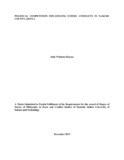POLITICAL COMPETITION INFLUENCING ETHNIC CONFLICTS IN NAKURU COUNTY, KENYA
Abstract
Ethnic conflict is one of the major threats to international peace and security. Conflicts in the Balkans, Rwanda, Chechnya, Iraq, Indonesia, Sri Lanka, India, Darfur, Israel and Gaza are among the best-known and deadliest examples from the 20th and 21st centuries that have led to tremendous human suffering. Political competitions within and between political parties in a society and other forms of violence have negatively affected many African societies, Kenya included. This has led to deaths, destruction of property and displacement of citizens. Ethnic conflict in Kenya has often taken place during electioneering periods and has been blamed on various factors such as historical injustices and ethnic differences among others. These are only triggers, while the real cause is the competition between political leaders. This study is based on the recurrence of ethnic conflict especially during electioneering period unlike other regions in the Country. The aggravating problem of ethnic conflict in Nakuru County needs to be comprehensively researched into to identify the missing elements towards sustainable peace. The general objective of this study was to investigate the influence that political competition has on ethnic conflicts in Nakuru County. The specific objectives were to: evaluate the nature of political competition in Nakuru County, examine the socio-economic context during non-electioneering period and establish solutions to ethnic conflicts caused by political competition in Nakuru County, Kenya. The choice of Nakuru County was determined by the fact that it has been the epicentre of ethnic conflicts since 1991 as compared to other Counties in Kenya. The study used a conceptual framework guided by three theories namely social change theory, conflict and structuralism theories. This was summarised in a conceptual model in explaining the relationship between political competition and ethnic conflicts. The study used mixed methods in which descriptive research design was used. The target population comprised of Nakuru County residents (men, women and children), Members of County Assembly (MCAs), religious leaders, Civil Society Organisations (CSOs) and local administrators (chiefs and assistant chiefs). A sample of 384 respondents was selected from Nakuru residents and 33 key informants: 9 Members of County Assembly, 8 Religious Leaders, 8 Civil Society Organisations (CSOs) and 8 Administrators, using probability and non-probability sampling techniques. This gave a sample size of 417 respondents. Both secondary and primary data were collected. Primary data was collected by use of questionnaire, focus group discussion, interview schedules and field observation. Secondary data was obtained through desk research, libraries and journals. Data collected was analyzed using Statistical Package for the Social Science (SPSS) version 21 and presented using two measures of distribution; percentages and frequencies. Key findings for the study were that though ethnic conflict experienced in Nakuru was blamed on ethnic differences, the main cause of these conflicts was the competition between political leaders, which was within or between political parties, where some were formed along ethnic lines. The analysis for the collected data also indicated that violence is blamed on other causes which are only used as triggers for incitements during electioneering period but residents peacefully co-exist during non-electioneering period. Possible solutions cited to these violence were good governance, moving back to single system of government and offering civic education to the citizens. Recommendations to the violence were the issues being used as triggers by the leaders should be fully addressed by the government and community agencies should be set up to identify and respond to their common problems. Overall conclusion is that ethnic conflict experienced in Nakuru County during electioneering period is not because of ethnic differences but as a result of political competition amongst the political protagonists. The significance of the study was that the study findings could be used by policy makers, the legislative and the commissions and religious organisations addressing conflicts in the area. The study findings would contribute to helping policy makers in coming up with new policies or editing the existing ones to address influence that political competition has on ethnic conflicts and add knowledge in the field of peace and conflict studies.

